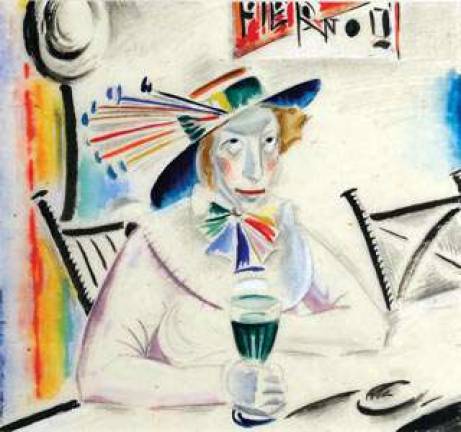By John Goodrich When America Met Modernism If the New York School marked the ascendancy of some uniquely American traits-a physical frankness, a zeal for open spaces and untamed possibilities, a practicality of expression-what, then, characterized the preceding decades of American art? The 40 paintings, sculptures, photographs and works on paper in Gerald Peters Gallery's Defining Modern provide some intriguing clues. Dating mostly to the first four decades of the 20th century, they reflect a broad mix of cutting-edge European trends and home-brewed realism. A number of works show a keen enthusiasm for the French School. Max Weber's cubist figure painting from 1912 suggests a lyrical, gentler version of Picasso, while the open, broad contours of his two watercolor landscapes (1911 and ca. 1912) recall Cézanne. Gaston Lachaise's bronze portrait of Alfred Stieglitz from 1928 shows a ragged naturalism, but two sculptures of nudes (1919 and 1924) by the Paris-trained sculptor ebb and swell with expressionistic energy. Sounding the opening notes of abstract expressionism, Arshile Gorky's monochromatic painting from 1945 plumbs Picasso's urgent side, catching fragments of a horse and figures with whiplash lines. Wary of modernism, other artists devote themselves to faithful recordings of the American heartland. Regionalist painter Grant Wood imparts a rich, moody light to rolling hills in a charcoal and pastel drawing from 1934. Though urban in temperament, Reginald Marsh's slightly overcharged rendering of a striptease from 1938 feels closer to American traditions of caricature than to contemporary European painting trends; his large fresco of a steam engine (1934) captures pistons, wheels and boiler with meticulous precision. Among several photographs, two by Stieglitz of nude torsos (dated 1918 and 1918-19) possess a straightforward sensuality transcending time and place; they could have been produced yesterday. One of the exhibition's surprises is the work produced by his model for these photographs, Georgia O'Keeffe, whose tiny monotype of a woman painting (ca. 1907-08) stands out for its exquisitely colorful atmosphere. Dated ca. 1925, a small, early painting by Thomas Hart Benton startles, too, for its vitality of color, almost fauvist in intensity and clarity. Works by Marin, Hartley, Archipenko and Demuth round out this elegant show. But the biggest revelation may be Marguerite Zorach's sparkling watercolor from 1913. In motif and style, it somewhat resembles Matisse's iconic "Joy of Life," painted just a few years before. Zorach, however, suffuses her arcadian scene with an original and slightly mystical air. Accompanied by delicate, stylized butterflies and a lone dragonfly, her figures lounge through a deftly layered space, as airy and sensuously flat as a Persian miniature. Defining Modern Through June 8, Gerald Peters Gallery, 24 E. 78th St., 212-628-9760, [gpgallery.com](http://www.gpgallery.com/).

